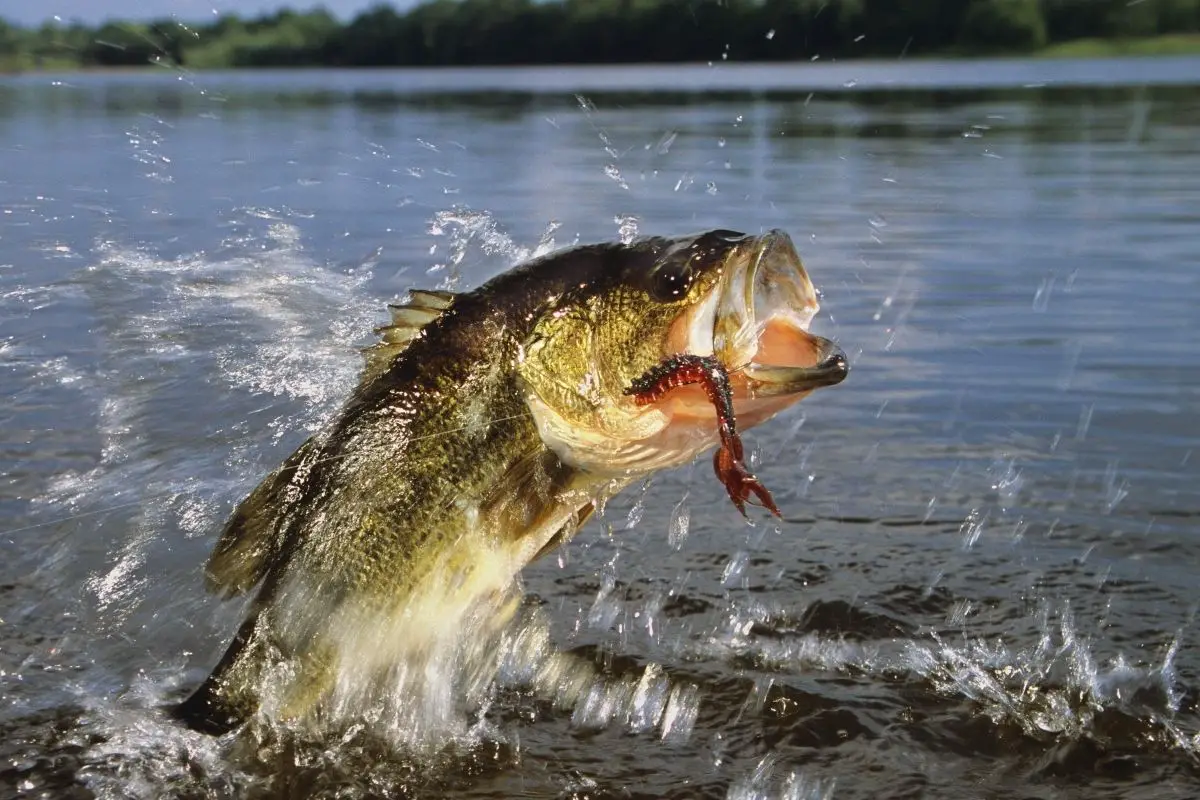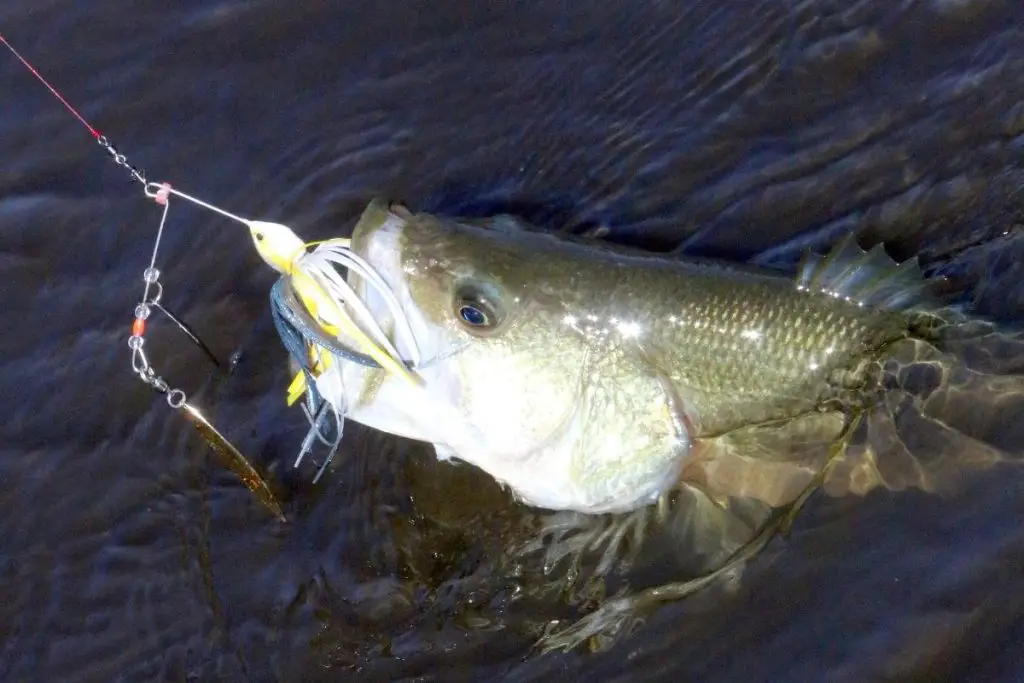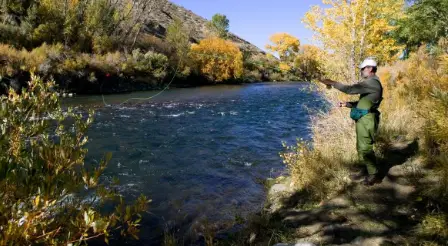The largemouth bass, or the Micropterus salmoides, is a freshwater gamefish and a species of black bass which are generally distributed across the eastern and central United States as well as Canada and northern Mexico but have been found elsewhere.
The largemouth bass is considered a gamefish which means they are very commonly fished. Ethically or not, the largemouth bass is sought after for its ‘fight’ when being caught. The bass will often aggressively resist being caught even by jumping out of the water and aggressively shaking itself.
What Is A Largemouth Bass?
A largemouth bass is a freshwater fish considered to be a gamefish. It is the state fish of Georgia and Mississippi, and the state freshwater fish of Florida and Alabama. This goes a long way to show the popularity of the fish across the United States, as well as the wide distribution across the states as well.
Morphology
The largemouth bass, signaled by its name, is one of the largest of all the black bass species. Additionally, there can be a wide range of sizes within the actual species of largemouth bass itself.
The females generally exhibit what is known as sexual dimorphism. This simply means that between the two sexes there can be a large amount of difference in their morphological features. In this case, the female largemouth bass specimens are almost always much larger than the males.
Generally the largemouth bass can reach over 29 inches in length and potentially 25 pounds in weight. These will likely be females, as the males can be much smaller. Interestingly, the bass can survive for over 15 years in the wild.
Of course, the largemouth bass has a large mouth. This mainly references the fact that the upper jaw of the bass extends beyond their eyes.
Feeding
The largemouth bass commonly feeds on large aquatic insects such as water fleas and bait fish while in juvenile stages.
As the bass grows they usually start to feed on smaller species of fish as well as snakes, salamanders and other amphibians.
In full maturity, female largemouth bass will often feed on younger fish from larger species such as young trout, catfish and other smaller bass species.
The largemouth bass can feed on anything as large as 50% of its body length.
Worth noting for anglers, that largemouth bass in weedy waters are generally much smaller in size as they struggle to feed on larger prey due to the weeds. If you want to catch a largemouth bass that is large then consider a different environment.
Spawning
Interestingly the common understanding of matriarchy and patriarchy within the animal kingdom is sort of turned on its head in the largemouth bass world.
Reaching sexual maturity after around a year, the male bass look for females to mate with. They swim around their nest together to mate. The eggs are then guarded by the male until they hatch after around 2 – 7 days.
Once the young bass can swim they swim out of the nest and the male father enters a hunting or feeding mode in the summer months as the spawning often takes place in spring.
How To Catch A Largemouth Bass

Tyger Leader is reader-supported and may earn a commission when you book or purchase using our links. Learn more about our affiliate disclaimer here.
As mentioned, the largemouth bass is a particularly sought after catch due to their aggressive resistance to being caught. Unfortunately, while this resistance certainly makes them seem like the angler’s perfect catch, this can also lead to a lot of accidental death even when ethical capture and release is their intention.
Within the angling community there is a lot of pressure for ethical capture and release as many of the specimens anglers seek to catch are the larger female species. Obviously, many of these female specimens are required for the spawning season and heavily contribute to a sustainable fishing stock for future capture and release.
Here are some of our tips to successfully catch bass.
Finding The Right Lure
Lures are a pretty important part of bass fishing. Many anglers put a lot of stock on which lure they use for what environment. Finding the right lure takes a lot of trial and error and also how you glean your success from each use of a different lure. It requires a keen angler’s eye.
Yet, many understand that your tackle box isn’t always the key to success when bass fishing. In other words, just because you have the best lures doesn’t mean you will catch bass. Moreover, different lures work for different styles of fishing as well.
Spinnerbait
Spinnerbaits have become particularly popular among the bass fishing community. They are best suited to aggressive fishers who want to fish fast, wrangling the bass themselves. This type of bait excels within shallow vegetative waters.
Yet, they can also be used in deep waters as the lead head drags downwards while the blade spins. The safety pin design allows the lure to deflect sticks and weed away from the hook to increase efficiency of the bait.
Jig Worms
Where the cover on the water isn’t too thick, a jig worm can be a good use of bait. As the jig worm is a very simple bait it is popular among anglers. Moreover, you can hold your whale days worth of bait in a compact container.
A light jig head with a light line can work best, especially once the bass is caught. A lighter jig allows you to wrangle with it more effectively. Mushroom or ball head jig heads can work best as the hook is exposed for the bass to latch onto.
As the hook is exposed it can be best to plant your jig on the edge of cover.to avoid snagging.
Weedless Jigs
These jigs are perhaps the most favored bait among the top bass fishers of the country, yet this doesn’t immediately lead to success and requires some skill.
The lure combines a compact frame, heavy-duty hook, and skirt that can be used in almost any water. The crawfish lure is ideal for attracting bass. The weight of this jig won’t affect size but will ultimately decide how deep the lure will sink.
These can even be really effective within thick vegetation. The lure can be dropped down vertically through the vegetation. This makes it particularly effective at catching bass.
Tips To Catch Bass
- Keep your hooks nice and sharp, it takes a mere 30 seconds per hook. But, this could seriously help you catch more bass as they have a quite boney jaw that can be hard to penetrate. You don’t want to get all the way to the final catch and lose out because your hook couldn’t penetrate.
- Cast into the wind. While distance can often be the key to fishing, sacrificing distance so that you can cast in the wind can make you more likely to catch a bass. Bass always swim with the current so they are more likely to find your bait this wary.
- As mentioned, the springtime is when bass start to spawn. In this season, simply cast into shallower waters so that you can get the bass protecting their nests. While a little unethical, this is effective.
- The pressure before a storm can make bass more active. If you know a storm is coming try fishing just before and you may catch more bass.
- Remain persistent. Bass are generally an ornery fish. They can be quite aggressive once caught as we detailed. In the same vein, if you constantly throw out lures in the same spot they may eventually bite out of sheer annoyance.
- Choose your bait depending on the season. Bass feed on different things depending on what season you are fishing in so do the research about what they are more likely to bite on. Moreover, bass when caught often vomit up their last meal, this can give you an idea of what they are eating specifically in that area.
- Those jig worms that seem to be all bashed and shredded can actually be your key to success. As bass often go for wounded prey thanks to their predator instinct this means that those battered jig worms may actually get more success than a new one.
Final Thoughts
Bass fishing, while popular, isn’t always as easy as you may expect. What is clear is that there are many ways to catch a bass, your success with each method can completely depend upon your own fishing style as well as the location you are in.
Using different baits and lures and finding which works best for you is ultimately the key. This means when you do have a successful catch, consider why you were successful rather than getting caught up at the moment. Using a journal is always helpful, noting the conditions, bait used, season, etc.
As with any fishing practice, ethical capture and release is always encouraged and recommended. The good thing with bass is that once you catch one, releasing them can be quite easy without such a high risk of mortality.
If we want to keep fishing bass for years to come, we have to respect their spawning grounds and also respect the fish population to keep the practice of angling going for as long as possible.



